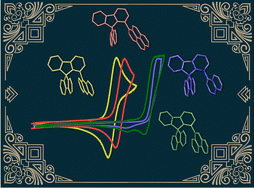Influence of the pendant substituent at the C1 position of a spirobifluorene scaffold on the electronic properties
Lambert Sicard, Clément Brouillac, Nicolas Leclerc, Sadiara Fall, Nicolas Zimmerman, Olivier Jeannin, Joëlle Rault-Berthelot, Cassandre Quinton and Cyril Poriel.
Materials Chemistry Frontiers, 2024 DOI: 10.1039/d3qm01106b
1-Substituted fluorenes have emerged in recent years as being among the most efficient functional materials for phosphorescence and thermally activated delayed fluorescence OLEDs. The position C1 of the fluorene is indeed highly interesting to design functional materials with specific properties. This scaffold displays two main characteristics. First, there is a strong p-conjugation disruption between the pendant substituent attached at C1 and the substituted fluorene. Second, the specific geometry of the C1-fluorene allows through-space interactions between the substituent attached at C1 and the cofacial building unit attached at C9. However, to date, this family of organic-semi-conductors has not been intensively studied yet. In this work, we report the synthesis and the structural, electrochemical and photophysical properties of four 1-substituted spirobifluorene derivatives, constructed with widely known extended p-conjugated systems: naphthalene, anthracene, phenanthrene and pyrene at the C1 position of spirobifluorene. Using a structure–property relationship approach, we show how the nature of the substituent grafted at C1 significantly modifies the electronic properties (HOMO/LUMO energy levels, triplet state energy levels, etc.). As 1-substituted spirobifluorenes are undoubtedly very promising organic semi-conductors, such a study provides fundamental knowledge to construct future efficient organic materials for specific applications.
